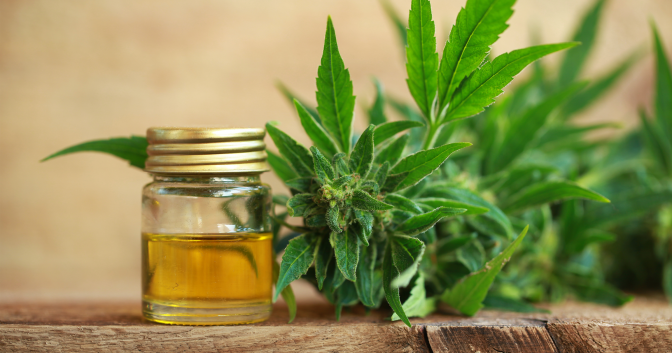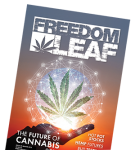The ABC’s of CBD

CBD, which stands for “cannabidiol,” is all the rage in the marijuana industry. It’s widely believed to play a key role in the plant’s healing properties. Despite its confusing legal status, CBD is currently available in dispensaries, adult-use shops and even grocery stores around the country. But does CBD work, and how can it benefit patients and general users?
A. WHAT IS CBD?
Cannabidiol is the second most abundant phytocannabinoid found in cannabis, after tetrahydrocannabinol (THC). It accounts for up to 40% of the plant’s extract. CBD is insoluble in water, but soluble in organic solvents. The precursor to CBD is cannabidiolic acid (CBDA), which is found in the resin glands of raw cannabis plants. Aging and decarboxylating (removing carboxyl ions, COOH, by heating) CBDA turns it into CBD.
CBDA also has a precursor, cannabigerolic acid (CBGA). It’s a precursor to tetrahydrocannabinolic acid (THCA) and cannabichromene acid (CBCA). CBGA turns into CBDA with the help of the cannabis plant enzyme CBDA synthase. Catalysis from CBGA to CBDA occurs through the same metabolic pathway as THCA, with the only difference being that there is another enzyme, THCA synthase, acting as a catalyst.
B. HOW DOES CBD WORK?
Studies have shown that CBD has a low affinity for the body’s CB1 and CB2 receptors. Indeed, CBD seems to work as a receptor agonist, meaning that it blocks or dampens a biological response by binding to a receptor, as opposed to provoking a response like an agonist, which is what THC does. This explains why CBD can help “smooth out” the effects of THC, as well as extend the duration of THC’s effects by increasing CB1 receptor density.
There’s also a gene in the human body that produces a protein known as “GPR55” or “G-protein coupled receptor 55,” GPR55 is activated by both THC and CBD, as well as the body’s own endocannabinoids, anandamide (which THC mimics), 2-arachidonoylglycerol (2-AG, found in breast milk) and noladin ether. GPR55 is mostly found in the caudate nucleus and putamen of the brain.
When CBD is consumed, it activates 2-AG, slowing the deterioration of anandamide. CBD also inhibits fatty acid amide hydrolase (FAAH), which increases the levels of endocannabinoids in the body as well as the body’s own natural THC. CBD also acts as a 5-HT1A receptor partial agonist—a subtype of 5-HT receptor that binds the neurotransmitter serotonin. This helps explain why CBD works as an antidepressant, anxiolytic (decreasing anxiety) and neuroprotective. 5-HT1A receptors are found mostly in the brain. Interestingly, CBD indirectly influences μ-opioid and δ-opioid receptors, which may help explain why cannabis can help replace opioid-based painkillers.
C. WHAT EFFECT DOES CONSUMING CBD HAVE?
CBD is not psychoactive (for most people) or toxic. Though it doesn’t have euphoric effects like THC, it definitely can help induce relaxation and reduce stress. Some sense a slight jolt of energy; the brain isn’t clouded, and people tend to feel “clear-headed” when using CBD. But there are definitely some physiological effects, a sort of “stoned without being stoned” response.
D. WHAT ARE THE MEDICAL BENEFITS OF CBD?
There are varying amounts of evidence regarding a number of conditions that CBD can help:
• It acts as an anticonvulsant. GW Pharmaceuticals is seeking FDA approval to market its high-CBD Epidiolex as a medication for epilepsy, Dravet syndrome and seizures in general.
• It acts as an antipsychotic. CBD can be used instead of antipsychotics prescribed for post-traumatic stress disorder (PTSD), attention-deficit hyperactivity disorder (ADHD), obsessive-compulsive disorder (OCD), severe depression, eating disorders and schizophrenia.
• It’s neuroprotective. CBD protects brain cells from the toxicity of glutamate, which builds up when oxygen fails to reach the brain. This means CBD can be useful for Parkinson’s disease, stroke, traumatic brain injury, and a variety of neurological disorders and problems. CBD also induces the growth of new brain cells (neurogenesis).
• It’s anti-inflammatory. Several studies have shown that cannabinoids reduce inflammation by down-regulating cytokine and chemokine production, and upregulating T-regulatory cells.
• It acts as an antidepressant. CBD works on the serotonin receptor 5-HT1A. Chronic antidepressant treatment also modifies and causes changes in the endocannabinoid system. The main benefit of CBD is that it can work for a multitude of conditions. It’s also faster-acting than many antidepressants, which can take months to work effectively.
E. WHAT’S THE BEST DELIVERY METHOD FOR CBD?
Joints, tinctures, oils, pens, topicals or edibles? Quite simply, try them all and pick whichever one works best for you. With smoking and vaping, CBD directly enters the bloodstream. Edibles are metabolized more slowly, by the liver. People often find that varying their methods of ingestion works. Why this is, nobody precisely knows, but the simple answer is “everyone’s different.”
Though CBD is generally safe, it may interact with other drugs, since it inhibits the activity of the liver enzyme cytochrome P450, which contributes to the metabolism of drugs by oxidizing them. While there aren’t many known negative drug interactions, the fact that cannabis works on cytochrome P450 suggests that it can have an effect on benzodiazepine and barbiturate absorption. Indeed, CBD can be used to taper people off benzos and barbs, but it may also have negative effects if both are used in high amounts.
To determine the best delivery method, ask your local budtenders and fellow patients for their opinions. Do some trial-and-error research and decide which ones work for you. Doctors can’t recommend one specific product, but I do suggest using ones that are lab-tested.
F. CBD-ONLY OR COMBINED WITH THC?
The phrase “a spoonful of sugar helps the medicine go down” applies to cannabis as well. A little bit of THC helps CBD do its job better. Many people prefer a 1:1 ratio of THC to CBD. A 2016 study of multiple sclerosis (MS) patients showed a generally positive response to the therapeutic effects of a 1:1 THC:CBD oromucosal spray.
However, the ideal ratio of THC:CBD is very much a personal matter, and it also depends on the condition one suffers from. Many people will likely need different cannabinoid ratios for different times of the day and for different conditions. For example, a THC-laden tincture would likely be a poor choice for a schizophrenic (who probably ought to stick to CBD-only), but terrific for a MS sufferer.
The “entourage effect” suggests that CBD works better when it’s paired with THC. However, these aren’t the only cannabinoids. There are more than 100 others that also have health benefits that can relax the body and induce sleep, fight pain and work as an appetite stimulant, such as cannabigerol (CBG)—which is a neuroprotective, anti-inflammatory and antibacterial agent—and cannabinol (CBN).
Whole-plant extracts and cannabis flowers may be the best way to go when it comes to getting the full spectrum of health benefits from marijuana. By separating THC and CBD, you’re receiving half of the benefit that you could be getting. Stripping away the other cannabinoids and terpinoids also makes the plant less effective as a medicine. Sadly, those substances are missing from many CBD-only products, making them less effective or even ineffective.
G. WHAT ABOUT CBD PRODUCTS MADE FROM HEMP, AND SOURCED FROM EUROPE AND OTHER COUNTRIES?
Hemp plants and marijuana plants are both the same species, Cannabis sativa, but they have distinct phytochemical compositions. Hemp is low in THC and high in CBD; marijuana is generally high in THC and low in CBD. Hemp grows tall, fast and with plenty of stalk; marijuana has been modified to be more of a shrub that produces buds.
Yet, there may well be a difference in the quality of the extracts. This has more to do with the plant’s growing conditions than the plant itself. Industrial hemp is often grown in countries where safety standards aren’t strictly adhered to, such as Romania and China. If cultivation and extraction aren’t done safely, heavy metals, pollutants and even pathogenic bacteria and fungi can find their way into hemp-derived CBD products. For now, it’s probably best to look for products made from organically cultivated hemp from North America (the U.S., Canada) or the European Union (the Netherlands, Spain), from countries that regulate and test their CBD products.
CBD derived from stalks and seeds may not be as effective as CBD derived from cannabis flowers. Medical marijuana, grown in controlled conditions where fewer industrial chemicals and pesticides are used, is clearly safer then its hemp counterpart. If you’re a patient and live in a legal medical-marijuana state, get a card and look for marijuana-derived CBD oils, edibles, topicals and tinctures.
H. IS CBD LEGAL?
Both CBD and hemp are illegal under federal law in the United States. However, this ban has openings depending on where the CBD is sourced from. CBD derived from marijuana flowers is illegal, whereas CBD derived from the mature stalks of hemp plants is legal—and a 2014 federal law allows states to create pilot programs for hemp cultivation. Thus, you might be able to get CBD products made in one of the 33 states that allow hemp cultivation in some form. In general, though, this legal situation has had the effect of flooding the U.S. market with cheap hemp oil from countries where safety standards are lax.
Last December, the DEA created a new code for “marihuana extracts,” which are defined under the Controlled Substances Act as “containing one or more cannabinoids that has been derived from any plant of the genus Cannabis, other than the separated resin.” With that ruling, CBD remains in a complex gray area of the law, one that continues to heavily affect the hemp, marijuana and cannabis industries.
If you enjoyed this Freedom Leaf article, subscribe to the magazine today!

